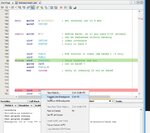wp100
Advanced Member level 6

- Joined
- May 15, 2009
- Messages
- 3,051
- Helped
- 884
- Reputation
- 1,783
- Reaction score
- 733
- Trophy points
- 113
- Location
- Prime Meridian
- Activity points
- 0
Hi,
Just to add on to that long video, you can see in this pic how to add a Breakpoint so when you use the Simulator and Debug then it will advance to the Breakpoint line and then stop waiting for you examine registers as shown in that vid or to Step or Go to the next breakpoint if your chip can do more than one.
You can also use the Debugger Stopwatch function to check the timing on your various delay and loops etc.
Just to add on to that long video, you can see in this pic how to add a Breakpoint so when you use the Simulator and Debug then it will advance to the Breakpoint line and then stop waiting for you examine registers as shown in that vid or to Step or Go to the next breakpoint if your chip can do more than one.
You can also use the Debugger Stopwatch function to check the timing on your various delay and loops etc.



